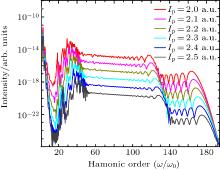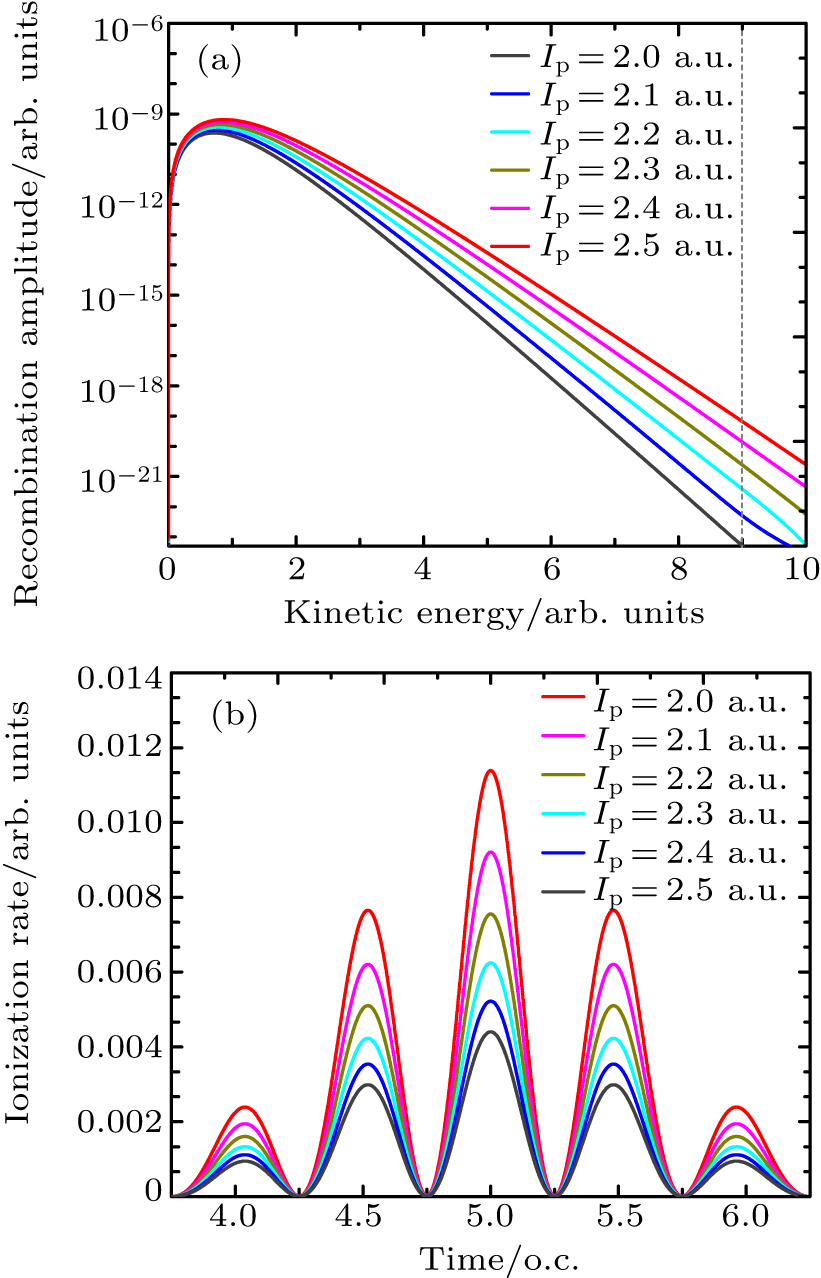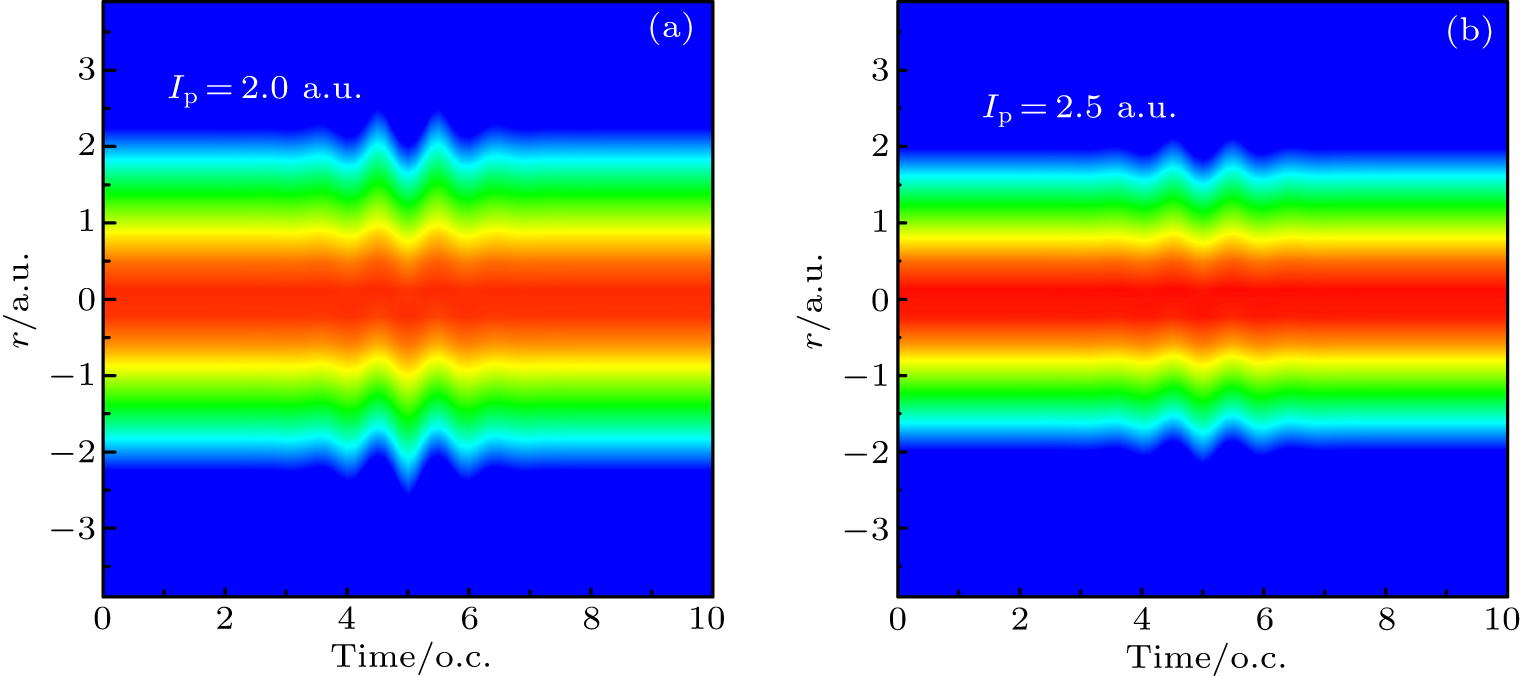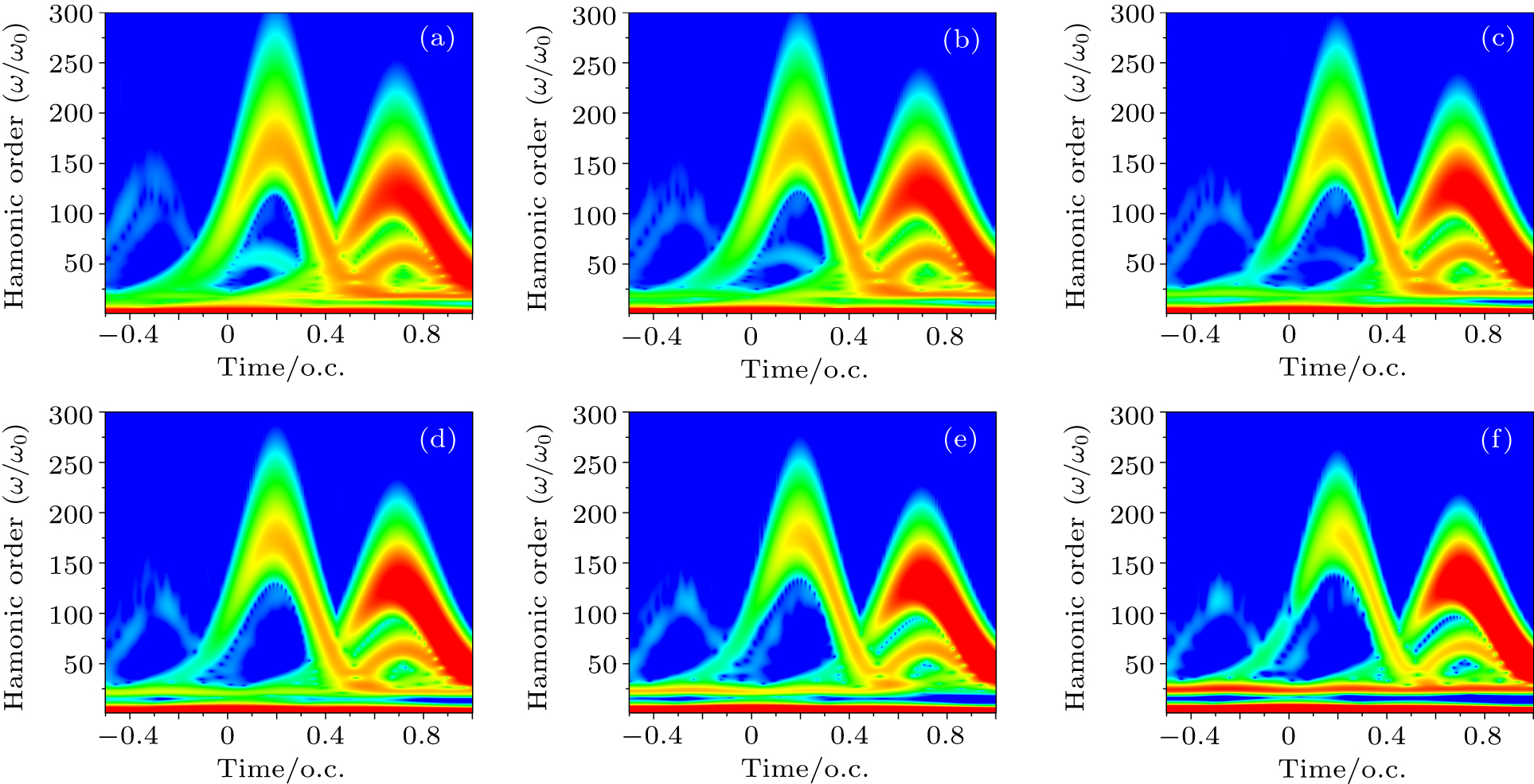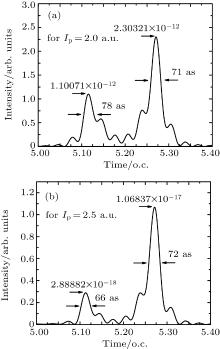中国物理B ›› 2020, Vol. 29 ›› Issue (10): 104207-.doi: 10.1088/1674-1056/ab9deb
-
收稿日期:2020-03-13修回日期:2020-05-03接受日期:2020-06-18出版日期:2020-10-05发布日期:2020-10-05 -
通讯作者:A Shahbaz
Role of quantum paths in generation of attosecond pulses
M R Sami and A Shahbaz†
- 1
Department of Physics, Government College University , P.O. Box 54000 Lahore,Pakistan
-
Received:2020-03-13Revised:2020-05-03Accepted:2020-06-18Online:2020-10-05Published:2020-10-05 -
Contact:†Corresponding author. E-mail: atif-shahbaz@gcu.edu.pk
中图分类号: (Frequency conversion; harmonic generation, including higher-order harmonic generation)
- 42.65.Ky
引用本文
M R Sami, A Shahbaz. [J]. 中国物理B, 2020, 29(10): 104207-.
M R Sami and A Shahbaz†. Role of quantum paths in generation of attosecond pulses[J]. Chin. Phys. B, 2020, 29(10): 104207-.
| [1] |
Douhal A, Lahmani F, Zewail A H 1996 Chem. Phys. 207 477 DOI: 10.1016/0301-0104(96)00067-5
|
| [2] |
Zewail A H 2000 J. Phys. Chem. A 104 5660 DOI: 10.1021/jp001460h
|
| [3] |
Nass K, Gorel A, Abdullah M M et al. 2020 Nat. Commun. 11 1814 DOI: 10.1038/s41467-020-15610-4
|
| [4] |
Goulielmakis E, Loh Z H, Wirth A, Santra R, Rohringer N, Yakovlev V S, Zherebtsov S, Pfeifer T, Azzeer A M, Kling M F, Stephen R L, Krausz F 2010 Nature 466 739 DOI: 10.1038/nature09212
|
| [5] |
Drescher M, Hentschel M, Kienberger R, Uiberacker M, Yakovlev V, Scrinzi A, Westerwalbesloh Th, Kleineberg U, Heinzmann U, Krausz F 2002 Nature 419 803 DOI: 10.1038/nature01143
|
| [6] |
Pal S K, Zewail A H 2004 Chem. Rev. 104 2099 DOI: 10.1021/cr020689l
|
| [7] |
Uiberacker M, Uphues Th, Schultze M, Verhoef A J, Yakovlev V, Kling M F, Rauschenberger J, Kabachnik N M, Schröder H, Lezius M, Kompa K L, Muller H G, Vrakking M J J, Hendel S, Kleineberg U, Heinzmann U, Drescher M, Krausz F 2007 Nature 446 627 DOI: 10.1038/nature05648
|
| [8] |
Calegari F, Trabattoni A, Palacios A, Ayuso D, Castrovilli M C, Greenwood J B, Decleva P, Martín F, Nisoli M 2016 J. Phys. B: At. Mol. Opt. Phys. 49 142001 DOI: 10.1088/0953-4075/49/14/142001
|
| [9] |
Hentschel M, Kienberger R, Spielmann C, Reider G A, Milosevic N, Brabec T, Corkum P, Heinzmann U, Drescher M, Krausz F, Schultze M 2001 Nature 414 509 DOI: 10.1038/35107000
|
| [10] |
Krausz F, Stockman M I 2014 Nat. Photon. 8 205 DOI: 10.1038/nphoton.2014.28
|
| [11] |
Fabris D, Witting T, Okell W A, Walke D J, Matia-Hernando P, Henkel J, Barillot T R, Lein M, Marangos J P, Tisch J W G 2015 Nat. Photon. 9 383 DOI: 10.1038/nphoton.2015.77
|
| [12] |
McPherson A, Gibson G, Jara H, Johann U, Luk T S, McIntyre I A, Boyer K, Rhodes C K 1987 J. Opt. Soc. Am. B 4 595 DOI: 10.1364/JOSAB.4.000595
|
| [13] |
Li X F, L’Huillier A, Ferray M, Lompré L A, Mainfray G 1989 Phys. Rev. A 39 5751 DOI: 10.1103/PhysRevA.39.5751
|
| [14] |
Milosevic N, Scrinzi A, Brabec T 2002 Phys. Rev. Lett. 88 093905 DOI: 10.1103/PhysRevLett.88.093905
|
| [15] |
Agostini P, DiMauro L F 2004 Rep. Prog. Phys. 67 813 DOI: 10.1088/0034-4885/67/6/R01
|
| [16] |
Krausz F, Ivanov M 2009 Rev. Mod. Phys. 81 163 DOI: 10.1103/RevModPhys.81.163
|
| [17] |
Balogh E, Kovacs K, Dombi P, Fulop J A, Farkas G, Hebling J, Tosa V, Varju K 2011 Phys. Rev. A 84 023806 DOI: 10.1103/PhysRevA.84.023806
|
| [18] |
Hansen K k, Bauer D, Madsen L B 2018 Phys. Rev. A 67 043424
|
| [19] |
Krause J L, Schafer K J, Kulander K C 1992 Phys. Rev. Lett. 68 3535 DOI: 10.1103/PhysRevLett.68.3535
|
| [20] |
Corkum P B 1993 Phys. Rev. Lett. 71 1994 DOI: 10.1103/PhysRevLett.71.1994
|
| [21] |
Pfeifer T, Gallmann L, Abel M J, Neumark D M, Leone S R 2006 Opt. Lett. 31 975 DOI: 10.1364/OL.31.000975
|
| [22] |
Feng X, Gilbertson S, Mashiko H, Wang H, Khan S D, Chini M, Wu Y, Zhao K, Chang Z 2009 Phys. Rev. Lett. 103 183901 DOI: 10.1103/PhysRevLett.103.183901
|
| [23] |
Feng L, Chu T 2011 Phys. Lett. A 375 3641 DOI: 10.1016/j.physleta.2011.08.039
|
| [24] |
Porat G, Heyl C M, Schoun S B, Benko C, Dörre N, Corwin K L, Ye J 2018 Nat. Photon. 12 387 DOI: 10.1038/s41566-018-0199-z
|
| [25] |
Zhai Z, Liu X 2008 J. Phys. B: At. Mol. Opt. Phys. 41 125602 DOI: 10.1088/0953-4075/41/12/125602
|
| [26] |
Peng Y, Zeng H 2008 Phys. Rev. A 78 033821 DOI: 10.1103/PhysRevA.78.033821
|
| [27] |
Häffner H, Beier T, Djekić S, Hermanspahn N, Kluge H J, Quint W, Stahl S, Verdú J, Valenzuela T, Werth G 2003 Eur. Phys. J. D 22 163 DOI: 10.1140/epjd/e2003-00012-2
|
| [28] |
Werth G, Alonso J, Beier T, Blaum K, Djekić S, Häffner H, Hermanspahn N, Quint W, Stahl S, Verdú J, Valenzuela T, Vogel M 2006 Int. J. Mass Spectrometry 251 152 DOI: 10.1016/j.ijms.2006.01.046
|
| [29] |
Kluge H J et al. 2008 Adv. Quantum Chem. 53 83
|
| [30] |
Kraft-Bermuth S, Andrianov V, Bleile A, Echler A, Egelhof P, Grabitz P, Kilbourne C, Kiselev O, McCammon D, Scholz P 2014 J. Low Temp. Phys. 176 1002 DOI: 10.1007/s10909-013-1002-7
|
| [31] |
Rudek B et al. 2013 Phys. Rev. A 87 023413 DOI: 10.1103/PhysRevA.87.023413
|
| [32] |
Young L, Kanter E, Krässig B et al. 2010 Nature 466 56 DOI: 10.1038/nature09177
|
| [33] |
Hoener M et al. 2010 Phys. Rev. Lett. 104 253002 DOI: 10.1103/PhysRevLett.104.253002
|
| [34] |
Abdullah M M, Anurag Jurek Z, Son S K, Santra R 2017 Phys. Rev. E 96 023205 DOI: 10.1103/PhysRevE.96.023205
|
| [35] |
Shahbaz A, Müller C, Staudt A, Bürvenich T J, Keitel C H 2007 Phys. Rev. Lett. 98 263901 DOI: 10.1103/PhysRevLett.98.263901
|
| [36] |
Shahbaz A, Bürvenich T J, Müller C 2010 Phys. Rev. A 82 013418 DOI: 10.1103/PhysRevA.82.013418
|
| [37] |
Gaarde M B, Schafer K J 2002 Phys. Rev. A 65 031406 DOI: 10.1103/PhysRevA.65.031406
|
| [38] |
Schafer K J, Gaarde M B, Heinrich A, Biegert J, Keller U 2004 Phys. Rev. Lett. 92 023003 DOI: 10.1103/PhysRevLett.92.023003
|
| [39] |
Zair A, Holler M, Guandalini A, Schapper F, Biegert J, Gallmann L, Keller U, Wyatt A, Monmayrant A, Walmsley I A, Cormier Auguste T, Caumes J P, Salieres P 2008 Phys. Rev. Lett. 100 143902 DOI: 10.1103/PhysRevLett.100.143902
|
| [40] |
Hu J, Han K L, He G Z 2005 Phys. Rev. Lett. 95 123001 DOI: 10.1103/PhysRevLett.95.123001
|
| [41] |
Lu R F, He H X, Guo Y H, Han K L 2009 J. Phys. B: At. Mol. Opt. Phys. 42 225601 DOI: 10.1088/0953-4075/42/22/225601
|
| [42] |
Zhang H, Han K L, Zhao Y, He G Z, Lou N Q 1997 Chem. Phys. letters 271 204 DOI: 10.1016/S0009-2614(97)00423-5
|
| [43] |
Eberly J H, Su Q, Javanainen J 1989 Phys. Rev. Lett. 62 881 DOI: 10.1103/PhysRevLett.62.881
|
| [44] |
Burnett K, Reed V C, Cooper J, Knight P L 1992 Phys. Rev. A 45 3347 DOI: 10.1103/PhysRevA.45.3347
|
| [45] |
Gordon A, Santra R, Kärtner F X 2005 Phys. Rev. A 72 063411 DOI: 10.1103/PhysRevA.72.063411
|
| [46] |
Feng L, Chu T 2012 J. Electron Spectrosc. Relat. Phenom. 185 39 DOI: 10.1016/j.elspec.2011.11.004
|
| [1] | Chang-Tong Liang(梁畅通), Jing-Jing Zhang(张晶晶), and Peng-Cheng Li(李鹏程). Phase-coherence dynamics of frequency-comb emission via high-order harmonic generation in few-cycle pulse trains[J]. 中国物理B, 2023, 32(3): 33201-033201. |
| [2] | Dong-Dong Cao(曹冬冬), Xue-Fei Pan(潘雪飞), Jun Zhang(张军), and Xue-Shen Liu(刘学深). Spectral shift of solid high-order harmonics from different channels in a combined laser field[J]. 中国物理B, 2023, 32(3): 34204-034204. |
| [3] | Yining Zhu(朱奕宁), Zixu Zhu(朱子虚), Anbang Pei(裴安邦), and Yong-Pan Gao(高永潘). Optomagnonically tunable whispering gallery cavity laser wavelength conversion[J]. 中国物理B, 2023, 32(2): 24206-024206. |
| [4] | Shu-Shan Zhou(周书山), Yu-Jun Yang(杨玉军), Yang Yang(杨扬), Ming-Yue Suo(索明月), Dong-Yuan Li(李东垣), Yue Qiao(乔月), Hai-Ying Yuan(袁海颖), Wen-Di Lan(蓝文迪), and Mu-Hong Hu(胡木宏). High-order harmonic generation of the cyclo[18]carbon molecule irradiated by circularly polarized laser pulse[J]. 中国物理B, 2023, 32(1): 13201-013201. |
| [5] | Yanbo Chen(陈炎波), Baochang Li(李保昌), Xuhong Li(李胥红), Xiangyu Tang(唐翔宇), Chi Zhang(张弛), and Cheng Jin(金成). Effect of laser focus in two-color synthesized waveform on generation of soft x-ray high harmonics[J]. 中国物理B, 2023, 32(1): 14203-014203. |
| [6] | Xiaoyu Liu(刘晓宇), Yong Zhang(张勇), Haoran Wang(王皓冉), Haomiao Wei(魏浩淼),Jingtao Zhou(周静涛), Zhi Jin(金智), Yuehang Xu(徐跃杭), and Bo Yan(延波). High frequency doubling efficiency THz GaAs Schottky barrier diode based on inverted trapezoidal epitaxial cross-section structure[J]. 中国物理B, 2023, 32(1): 17305-017305. |
| [7] | Dong Tang(唐栋) and Xue-Bin Bian(卞学滨). Multiple collisions in crystal high-order harmonic generation[J]. 中国物理B, 2022, 31(12): 123202-123202. |
| [8] | Lixin He(何立新), Xiaosong Zhu(祝晓松), Wei Cao(曹伟), Pengfei Lan(兰鹏飞), and Peixiang Lu(陆培祥). Attosecond spectroscopy for filming the ultrafast movies of atoms, molecules and solids[J]. 中国物理B, 2022, 31(12): 123301-123301. |
| [9] | Xiaofan Zhang(张晓凡) and Xiaosong Zhu(祝晓松). Yield enhancement of elliptical high harmonics driven by bicircular laser pulses[J]. 中国物理B, 2022, 31(11): 114209-114209. |
| [10] | Ping Li(李萍), Na Gao(高娜), Rui-Xian Yu(蔚瑞贤), Jun Wang(王俊), Su-Yu Li(李苏宇), Fu-Ming Guo(郭福明), and Yu-Jun Yang(杨玉军). Amplitude and rotation of the ellipticity of harmonicsfrom a linearly polarized laser field[J]. 中国物理B, 2022, 31(10): 103303-103303. |
| [11] | Xiao-Zhuo Qi(祁晓卓), and Xi-Feng Ren(任希锋). Enhancement of the second harmonic generation from monolayer WS2 coupled with a silica microsphere[J]. 中国物理B, 2022, 31(10): 104203-104203. |
| [12] | Zheng Ge(葛正), Chen Yang(杨琛), Yin-Hai Li(李银海), Yan Li(李岩), Shi-Kai Liu(刘世凯), Su-Jian Niu(牛素俭), Zhi-Yuan Zhou(周志远), and Bao-Sen Shi(史保森). Up-conversion detection of mid-infrared light carrying orbital angular momentum[J]. 中国物理B, 2022, 31(10): 104210-104210. |
| [13] | Ming-Wei Qiu(邱明伟), Chao-Qun Cai(蔡超群), and Zu-Xing Zhang(张祖兴). Spatiotemporal mode-locked multimode fiber laser with dissipative four-wave mixing effect[J]. 中国物理B, 2022, 31(10): 104207-104207. |
| [14] | Long Lin(林龙), Tong-Gang Jia(贾铜钢), Zhi-Bin Wang(王志斌), and Peng-Cheng Li(李鹏程). Probing subcycle spectral structures and dynamics of high-order harmonic generation in crystals[J]. 中国物理B, 2022, 31(9): 93202-093202. |
| [15] | Ce Bian(边策), Jianwei Shi(史建伟), Xinfeng Liu(刘新风), Yang Yang(杨洋), Haitao Yang(杨海涛), and Hongjun Gao(高鸿钧). Optical second-harmonic generation of Janus MoSSe monolayer[J]. 中国物理B, 2022, 31(9): 97304-097304. |
|
||



